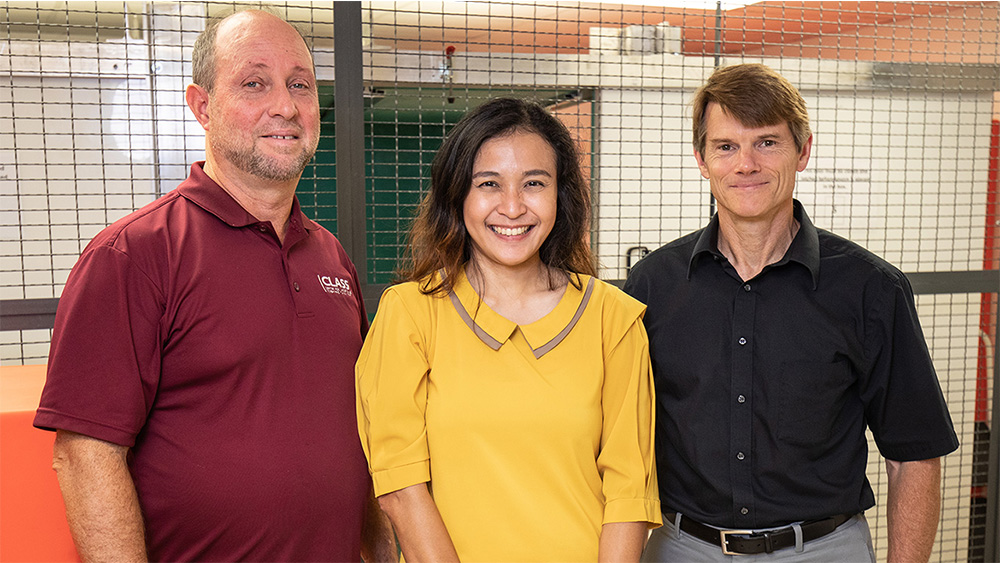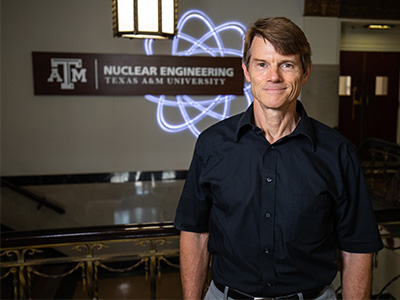
Imagine you have a 1985 Jaguar XJ6, but it hasn’t run since 1992. It’s 2018 and your job is to ensure that it will not only work, but start on the first try. You maintain the car, but some parts aren’t made anymore and you have to make them yourself. This is the world of the U.S. nuclear-weapons stockpile, and Dr. Marvin Adams and his Texas A&M University collaborators are helping national-security professionals navigate this tricky world.
The first nuclear weapon explosion was in 1945, and from 1945 to 1992 the testing of U.S. nuclear bombs took place largely in the South Pacific before moving underground in Nevada to alleviate environmental concerns. “You didn't have to understand things perfectly then,” he said. “It was an era of physical testing.”
In 1992, the explosive testing of nuclear weapons in the United States ended, and in 1996 the United States signed (but has not yet ratified) the Comprehensive Test Ban Treaty, which bans nuclear-explosive testing across the globe.

The United States has not developed new nuclear weapon designs since the end of testing, but instead has been refurbishing some, retiring others, and making repairs and replacing parts in others. “Materials degrade over time, but our experts still have to ensure they will work,” said Adams, adding that guaranteeing the weapons are still functional is imperative to the goals of nuclear deterrence. That’s where predictive computational modeling comes in.
“One place where Texas A&M is unquestionably strong is predictive science and engineering in the area of particle transport (neutrons, photons and charged particles),” said Adams. “We have unique strengths in this area.”
Adams is a professor of nuclear engineering, associate director of the Institute of National Security and Cybersecurity Education and Research, deputy director of the Texas A&M Engineering Experiment Station Center for Exascale Radiation Transport (CERT), and holder of the Heat Transfer Research Inc. endowed professorship. He credits the success of the predictive computational modeling group to the collaboration among Dr. Jim Morel and Dr. Jean Ragusa (nuclear engineering), Dr. Lawrence Rauchwerger and Dr. Nancy Amato (computer science), Dr. Bani Mallick (statistics), and Dr. Jean-Luc Guermond, Dr. Raytcho Lazarov, and Dr. Bojan Popov (math).
“We feel fortunate to have such an excellent multidisciplinary group,” said Adams. The team has a long history of developing methodologies that U.S. national laboratories have adopted and use in their daily work.
The team develops predictive science and engineering methods that help national laboratory experts calculate the effects of time on the weapons and their probabilities of success. The more time passes from when the devices were originally tested prior to 1992, the more difficult the calculations become as the materials degrade over time and devices change from tested configurations through refurbishments or repairs. Eventually, each type of nuclear weapon will have to be refurbished or replaced. How do you verify the calculations and run through every variable?
“Very carefully,” said Adams. “Anybody can calculate an answer, but calculating how accurate your answer is and predicting uncertainties is extremely difficult.”
Supporting National Security
Adams and his team are currently working on several projects in this realm. Each is sponsored by the Department of Energy’s National Nuclear Security Administration (NNSA) or one of its laboratories.
The team is currently working on an $11 million project for the CERT. “An important phenomenon in nuclear weapons is thermal radiation transfer,” he said. “We figure out how to develop and test predictive methods for thermal radiation transfer by using neutron transport as a surrogate. We design complicated neutron transport experiments, predict the results, predict how close our answers should be to reality, execute the experiments then compare the experimental results to our predictions.”
Lawrence Livermore National Lab (LLNL) has sponsored two of the team’s current projects: ‘Computational R&D in Support of Stockpile Stewardship’ ($1.4 million) and ‘Collaborative R&D in Support of LLNL Missions’ ($1.5 million). These two projects are developing advanced computational methods and new computational results that support the nation’s nuclear deterrent and other national security missions for which LLNL is responsible. The projects, which are the third set of three-year projects from LLNL that Morel has led with Adams as Co-PI, grew out of Texas A&M's role as an affiliate of Lawrence Livermore National Security, LLC—the organization that manages LLNL for the NNSA.
“The expertise we’ve developed here at Texas A&M is part of what made us an attractive partner in the competition for the contract to manage and operate the Los Alamos National Laboratory (LANL),” said Adams. The Texas A&M University System, the University of California and The Battelle Memorial Institute, united by their shared commitment to national service, formed Triad National Security, LLC, which competed against several other groups and was awarded the LANL contract in June of 2018. The Triad team assumed management of LANL on November 1.